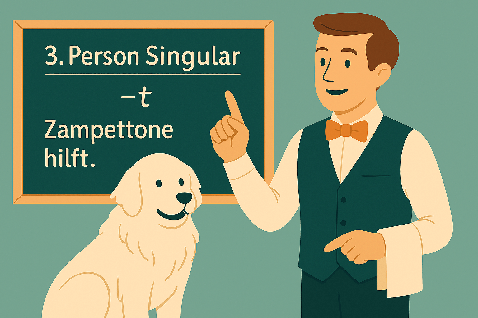Zampettone hilft
Situation
Zampettone brings a small flock of single words and phrases. For each character in the hotel, he has an example.

Lesson
The waiter becomes visible and explains the rules for the present indicative, only in the 3rd person singular. Only S + P (subject and predicate). In English, so Oliver can understand too. With all the rules.

1 · Regular (weak) verbs
Rule: Stem ends in any letter except -d/-t; no vowel change. Add -t.
Core example: Max malt. (Max paints.)
2 · Stem ends in -d / -t + consonant
Rule: Insert an extra -e- for pronunciation → -et.
Core example: Der Kellner arbeitet. (The waiter works.)
3 · Verbs ending in -eln / -ern
Rule: Keep -el- / -er-, then add -t.
Core example: 1. Elisa lächelt. (Elisa smiles.)
2. Oreste klettert. (Oreste climbs.)
4 · Verbs ending in -ieren
Rule: Regular conjugation. Add -t.
Core example: Frau Mutter kritisiert. (Mrs Mutter criticizes.)
5 · Stem-changing verbs, e → ie
Rule: Vowel change appears only in du and er/sie/es. Add -t.
Core example: Ermanno liest. (Ermanno reads.)
6 · Stem-changing verbs, e → i
Rule: Vowel change only in du and er/sie/es. Add -t.
Core example: Zampettone hilft. (Zampettone helps.)
7 · Stem-changing verbs, a → ä
Rule: Vowel change only in du and er/sie/es. Add -t.
Core example: Oliver schläft. (Oliver sleeps.)
8 · Inseparable-prefix verbs (be-, ver-, er-, emp-, ent-, miss-, zer-)
Rule: Prefix never detaches; otherwise conjugate like a regular verb (-t).
Core example: Ermanno versteht. (Ermanno understands.)
The waiter gives a key takeaway: In the 3rd-person singular, every German verb ends in -t (or -et)—and, for the strong verbs, you may see a vowel change.
Oliver's Homework
Write all the learned sentences in your notebook and read them aloud.
Ermanno's Homework
Zampettone's Word Flock

Oreste's Challenge

Your extra exercise is waiting for you at the end of the lesson!